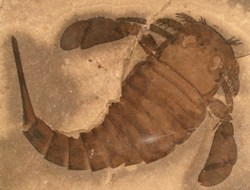
Remains of original chitin-protein complex - structural materials containing protein and polysaccharide - are abundant in Palaeozoic arthropod fossils, writes Ted Nield.
Geoscientist Online 9 February 2011
The discovery of chitin-protein complex molecules in Silurian fossils extends the fossil record of these molecules by almost 400 million years. Previously, the oldest molecular signature of this type had been seen in Cenozoic fossils a mere 25 million years old, though remnants of structural protein had also been discovered in rare 80 million year-old Mesozoic fossils.
Professor George Cody (Carnegie Institution for Science) and an international team of scientists including Professor Andrew C Scott (Department of Earth Sciences, Royal Holloway, University of London) discovered the relict protein-chitin complex in a 310-million-year-old (Carboniferous) scorpion cuticle from northern Illinois and a 417 million year-old (Silurian) eurypterid - an extinct scorpion-like arthropod, possibly related to horseshoe crabs—from Ontario, Canada (picture, courtesy, Yale University). The findings, published today by
Geology online, could have major implications for our understanding of the organic fossil record, Scott told
Geoscientist.
The outer portion of arthropod exoskeletons - the cuticle - is a composite material consisting of chitin fibres embedded in a protein matrix. Both chitin and structural protein decay easily, and it has long been thought that they would never be found in fossils of even moderate age, let alone in fossils from the early Palaeozoic.
Using a sophisticated analytical instrument called a XANES (X-ray Absorption Near Edge Structure) spectroscope at the Advanced Light Source facility (USA), the team measured low-energy X-ray absorption spectra of carbon, nitrogen, and oxygen atoms in the fossil material at a resolution of around 25 nanometers. This high-resolution microscopy revealed the complex laminar variation characteristic of arthropod cuticle. The researchers found, to their surprise, that most of the carbon, nitrogen and oxygen found in these fossils – as much as 59% in the in the scorpion and 53% in the eurypterid - derived from protein-chitin complex.
Not surprisingly, the material was somewhat degraded, either by chemical processes or partial bacterial decay. However, Cody believes that the vestigial protein-chitin complex may have played a critical role in preserving the organic material by providing a substrate that was protected from total degradation by a coating of waxy substances that in life protected the arthropods from desiccation.
Scott told
Geoscientist: “This research will aid our understanding of the fossilisation process, and this new technique allows us to reveal the chemical nature of a fossil without total destruction”.
Reference
- Molecular signature of chitin-protein complex in Paleozoic arthropods Geology (2011; DOI: 10 1130/G31648 1). G D Cody, N S Gupta, D E G Briggs, A L D Kilcoyne, R E Summons, F Kenig, R E Plotnick, A C Scott.